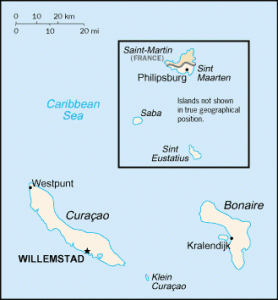St. Maarten
 St. Maarten is an island with a split personality, thanks to an international border between its two sides: Dutch St. Maarten to the south, French St. Martin to the north. Its capital, Philipsburg – a popular stop for cruise ships – began as a Dutch trading center, and forts around the city are reminders of its strategic importance in St. Maarten’s history. Fort Amsterdam, built in 1631, was the first Dutch military outpost in the Caribbean; the Spanish captured the fort soon after it was completed and kept it until 1648, when they abandoned it. Fort Willem, today topped by a television transmission tower, is great for a hike.
St. Maarten is an island with a split personality, thanks to an international border between its two sides: Dutch St. Maarten to the south, French St. Martin to the north. Its capital, Philipsburg – a popular stop for cruise ships – began as a Dutch trading center, and forts around the city are reminders of its strategic importance in St. Maarten’s history. Fort Amsterdam, built in 1631, was the first Dutch military outpost in the Caribbean; the Spanish captured the fort soon after it was completed and kept it until 1648, when they abandoned it. Fort Willem, today topped by a television transmission tower, is great for a hike.
Today tourism is king; bustling Front Street in Philipsburg beckons bargain hunters with 500 duty-free shops. There are 36 sugary sand beaches to visit; one favorite strip is Cupecoy Bay Beach near the Dutch-French border, and windsurfers head to busy Maho Bay Beach, located near the airport. One of St. Maarten’s more private strands is Simpson Bay Beach. Simpson Bay Lagoon is enclosed, making the water a natural for water skiing. Dawn Beach, Oyster Pond and Guana Bay are favorites for snorkeling and windsurfing.
Divers can explore an 1801 British frigate, the coral-covered HMS Proselyte, which sits a mile off the coast. Visitors can lounge on the beach or spend time mountain biking, horseback riding, hiking, playing tennis, or participating in watersports. Adventurers may want to try kiteboarding and operators on the island can also arrange for parasailing, windsurfing and Wave Runner excursions with instruction. Sailing is very popular; experience the thrill of the daily 12-Metre Challenge, a three-hour staged version of the America’s Cup race. Sailors of every skill level can serve as a member of the crew aboard the boats.
Visit the St. Maarten Park, a part of the St. Maarten Zoological and Botanical Garden, filled with Caribbean and South American animals, plants and birds. Spot sleek ocelots and bush dogs, parrots, toucans and owls, boa constrictors and marine toads, even land crabs and giant land snails. After dark, dinner is an international affair, with more than 300 restaurants offering French, Dutch, Caribbean, Italian, Chinese, Indonesian, creole and West Indian menus. Later in the evening, consider visiting one of 12 casinos. Gaming on St. Maarten is “European mode,” quiet and sophisticated.
General Description:
| Language | The official language of St. Maarten is Dutch, but the islanders speak mostly English with a West Indian lilt. The Dutch side also includes French and Spanish-speaking populations, and immigrants from Aruba, Bonaire and Curaçao have added Papiamento (based on Spanish, French, English, Dutch and Arawak Indian) to the mix. |
| Government | Constitutional monarchy |
| Location | The island is in the Caribbean Sea, 18.02 latitude and 63.07 longitude, 150 miles southeast of Puerto Rico. |
| Climate and Temperature | Mean temperature is 80 degrees F year-round; 45inches of rainfall annually. |
| Driving | Driving is on the left-hand side of the road, and a driver’s license is required. |
| Currency | Netherlands Antillean florin (NAf) |
| St. Maarten – Capital | Phillipsburg |
| Airport: | Princess Juliana International Airport |
| Land Area | 16 sq. miles |
| Population | Approx 74,826 |
| Ministry of tourism | +599 542 2337 |
| Website | http://www.st-maarten.com/ |

